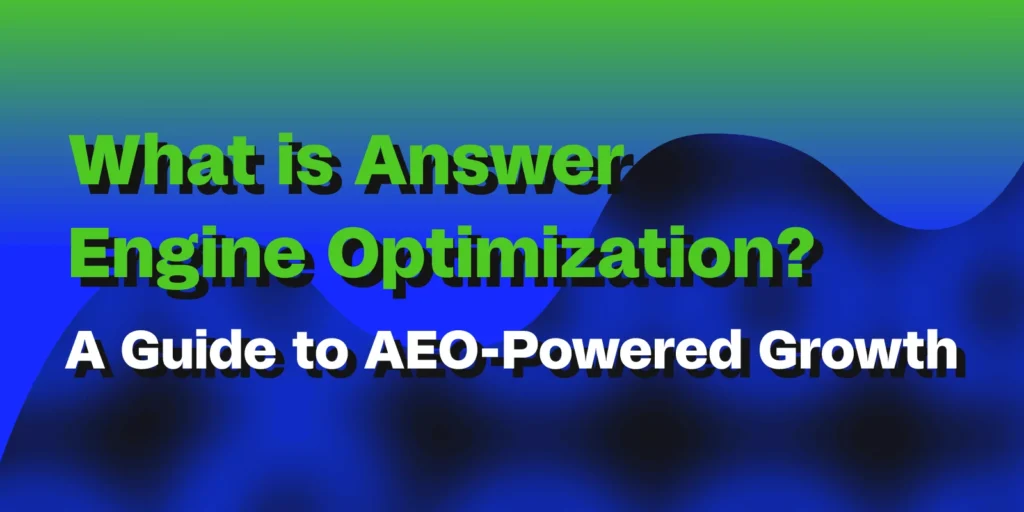Search has changed. People aren’t just typing keywords anymore — they’re asking full questions, expecting clear answers, and skipping the scroll. Whether it’s through Google’s AI Overviews, ChatGPT, voice search, or smart assistants, users are starting their buying journey by asking. That shift is exactly why Answer Engine Optimisation (AEO) has moved from niche tactic to strategic essential.
If you’re building a brand today, being found isn’t enough — you need to be chosen as the answer. And more marketers, founders, and ecommerce teams are catching on.
In this post, we’re unpacking why AEO is gaining traction across industries, and how brands are using it to grow faster, convert smarter, and stay ahead.
What’s Fuelled the Rise of AEO?
Search is getting smarter. AI engines are evolving from search engines into answer engines. And that means your content is being judged less on how many keywords it uses, and more on whether it delivers direct, trusted, useful answers.
AEO is about shaping your content — and your site — so it’s eligible to be chosen as that answer. It’s SEO evolved.
The uptick in AEO adoption is being driven by:
- Google AI Overviews and featured snippets: More search results are now summarised, not listed.
- Chatbots like ChatGPT: Users ask product, brand, or how-to questions and expect quick, linkable responses.
- Voice search and smart assistants: People ask questions naturally — and voice responses tend to pull from top-answer content.
- Consumer behaviour: Shoppers want to compare, validate, and decide without digging. If your brand makes it easy, you win.
The Brands That Are Winning with AEO
Let’s be clear: AEO isn’t just for massive sites with content teams and budgets. Smaller, agile brands are starting to outpace the big players by answering smarter.
Here’s how different types of brands are using AEO to fuel growth:
1. Ecommerce brands creating product FAQs and buyer guides
From fashion to fitness to tech, ecommerce teams are realising that product descriptions aren’t enough. By adding detailed FAQs, how-to guides, and comparison pages — all marked up with schema — they’re making sure they show up when someone asks:
- “Best wireless headphones for gym”
- “What size resistance band should I buy?”
- “Are these trainers waterproof?”
Those answers are getting surfaced by AI tools and driving high-intent traffic right to PDPs.
2. SaaS and tech companies creating support-led content
AEO isn’t just for selling products. It’s becoming a cornerstone of support-led growth — where brands create answerable content that helps users onboard, troubleshoot, and understand.
By structuring content to match natural queries like:
- “How do I integrate X with Y?”
- “What’s the best CRM for freelancers?”
- “Can I automate invoices with this tool?”
…these companies are meeting their audience at decision-making moments and building trust before the sign-up.
3. Personal brands and creators building authority
Bloggers, consultants, and micro-brands are using AEO to position themselves as experts. Instead of just creating opinion content, they’re reverse-engineering questions people are actually asking, and becoming the top answer.
This shifts their traffic from casual to considered — and when they sell a course, service, or product, conversions come from a place of trust.
What AEO Actually Looks Like in Practice
If you’re wondering what these brands are doing behind the scenes, here’s a peek at the practical, repeatable AEO playbook:
1. Keyword research becomes question research
Instead of starting with “trainers” or “CRM software”, AEO-led brands are using tools to surface what people are really asking. That might include long-tail questions, product comparisons, or “versus” queries.
2. Content is shaped around answers, not articles
The best AEO content is direct, helpful, and structured for clarity. That means:
- Questions as headings (H2s/H3s)
- Concise, confident answers under 100 words
- Follow-up context or links for depth
- Internal links to relevant products, support, or services
3. Schema is used properly
FAQ schema, How-To schema, Product schema — these aren’t extras. They’re signals. Structured data helps answer engines understand that your content is trustworthy, relevant, and ready to feature.
4. Pages are built with performance in mind
Fast loading, mobile-friendly, and easy to scan — these factors matter more than ever, especially when AI tools are trying to find content that works well across devices and platforms.
5. Results are measured through new metrics
Brands are starting to track beyond rankings and sessions. They’re using tools like GA4 and GSC to monitor impressions, clicks from AI summaries, and even referral paths from tools like ChatGPT. It’s early, but smart marketers are already tagging, testing, and iterating.
Why Brands Are Prioritising AEO Now
AEO isn’t just another trend. It’s a response to how people now search, learn, and buy. More brands are leaning in because:
- Visibility is shrinking: With AI-generated answers taking up more space, brands need to be part of the answer or risk being invisible.
- Buying journeys are shorter: Users are making decisions faster — often within one or two interactions. Being the first credible answer can win the sale.
- The cost of ads is rising: Paid channels are getting more competitive. AEO offers a sustainable, organic way to get discovered — without bidding wars.
- Trust is shifting: People trust answers more than ads. AEO content feels helpful, not salesy — which makes it more persuasive by nature.
From challenger brands to established players, more marketers are putting AEO at the centre of their content and search strategy. Not because it’s trendy — but because it’s working. And in a world where visibility means everything, being the answer is becoming the best strategy of all.


